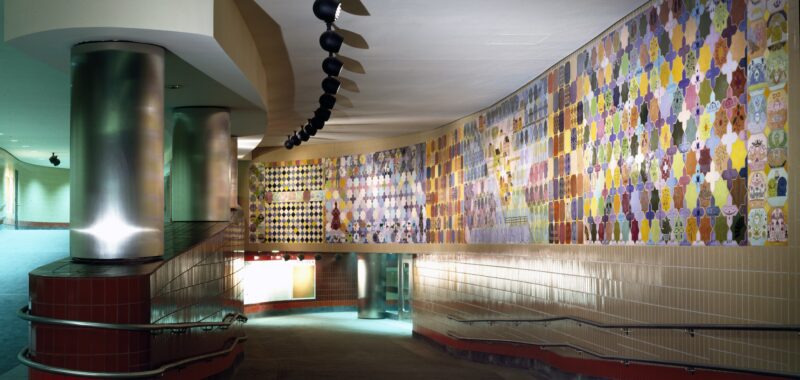Walk through Cambridge’s Harvard Square station on any given day and you’re bound to catch a glimpse of artist Joyce Kozloff’s 83-foot-long prismatic “New England Decorative Arts” mural. Located above the curved ramps leading to the subway station’s bus terminal, the quilt-like work features hundreds of interlocking hand-painted tiles containing scenes from New England’s landscape and motifs referencing the region’s history, like gravestones, weathervanes, sail boats, houses with steeply pitched roofs, and silhouettes of Indigenous individuals and European settlers.
Initially installed in 1985, it was Kozloff’s first public art commission, exemplifying the artist’s pioneering work in the ’70s and ’80s Pattern and Decoration movement. A year earlier, sections of the work were shown in an exhibition at MoMA PS1. But in the four decades since its installation, deteriorating conditions in the city’s subway system, also known as the T, have increasingly threatened the longstanding homage to regional history and feminist art.

Kozloff told Hyperallergic that deficiencies in the wall’s infrastructure are the root cause of the work’s current condition. She was already forced to restore a crumbling section of tiling due to a misplaced joint back in 1986.
“I knew even then that unless the wall was rebuilt, the tiles at that location would crack again, and of course, they did,” Kozloff said, citing other issues including additional cracking from a collapsing cantilever and damage from moisture leaking from the street.
“[The damage] gets worse and worse, and is not restorable,” the artist continued, adding that the only solution at this stage would be to install a completely new artwork. She estimates that such a project would require upwards of $1 million in funding to cover replacement tiles, shipping, demolition, and construction costs.
In recent years, Kozloff has received letters of support from both the director of the Cambridge Arts Council and former Cambridge Mayor Sumbul Siddiqui, but she says she needs the backing of either the MBTA CEO or the Massachusetts governor in order to raise the funds.


The work was supported by the Arts on the Line program — an initiative known today as “Arts on the T” that helped integrate public art into six subway stations across Boston and Cambridge. Implemented by the Cambridge Arts Council and the Massachusetts Bay Transportation Authority (MBTA), the program helped inspire similar efforts in transportation systems in cities like New York, Los Angeles, and Miami.
Kozloff’s mural is not the only artwork at the Harvard Square station to have suffered conservation issues. György Kepes’s stained-glass work “Blue Sky on the Red Line” (1985) also had problems with burnt-out backlighting fixtures and in required $40,000 in restoration repairs in 1998. Late Harvard professor Dimitri Hadzi’s 20-foot granite sculpture “Omphalos” (1985) stood outside the station’s main entrance for decades before it was removed in 2013 due to deterioration (the MBTA said it could not afford the repairs).
The state of the T’s public art is only a small part of the issues plaguing the historic underground subway system, which has been dealing with a multitude of track and station maintenance issues that the agency says it needs $24.5 billion to address.
“The MBTA recognizes the importance of public art in humanizing our system and enhancing the travel experience of our riders,” the agency’s Deputy Press Secretary Lisa Battiston told Hyperallergic. “When new art is included today … the art is required to be composed of resilient and durable materials, like ceramic tile, glass, and concrete, that are easier to maintain and can withstand existing within the conditions of our public transportation network.”

While the MBTA did not answer Hyperallergic’s inquiries about any initiatives to fix Kozloff’s mural, Battiston did say that the agency “continues to explore and evaluate opportunities to upgrade its historic art pieces, including related costs, manpower, time, and access.”
“With a number of competing priorities, challenging decisions need to be made as we continue to make upgrades to our tracks, signals, and other infrastructure, which are critical to our mission of providing safe, reliable transit service,” Battison said.
In the meantime, Kozloff, now 81 years old, has been digitizing tile designs on her iPad so her work could be potentially restored in the future.
“These files can be printed with high fire glazes on stoneware tiles, if and when there is the funding, desire and will to do it, and whether I’m around or not,” Kozloff said, adding that she has coordinated the plans with longtime Italian collaborators.
“I don’t know what else I can do, except make some noise!”





